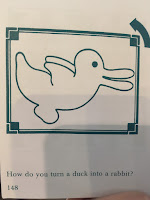Where the Wild Things Are
Written and Illustrated by Maurice Sendack
Grades: Pre-K to 3rd
Awards:
- Winner, 1964 Caldecott Medal
- Notable Children's Books of 1940-1970 (ALA)
- 1981 Boston Globe-Horn Book Award for Illustration
- 1963, 1982 Fanfare Honor List (The Horn Book)
- Best Illustrated Children's Books of 1963, 1982 (NYT)
- A Reading Rainbow Selection
- 1964 Lewis Carroll Shelf Award
- Children's Books of 1981 (Library of Congress)
- 1981 Children's Books (NY Public Library)
- 100 Books for Reading and Sharing 1988 (NY Public Library)
Max is in his wolf suit and runnning around his house. His mother calls him a wild thing and sends Max to his room. Max is very mad about having to go to his room. He imagines his room turning into a fantasy world full of other wild things like himself. Max is the greatest wild thing so the monsters make him thier king. Max eventually feels lonely and wants to go back home. When he is home again he finds that everything is the same and his mom still loves him.
In the classroom this would be a good book to read to show students that your imagination can take you anywhere. It will also show them that no matter how you act your mom still loves you.
The illustrations in the book are great. The pictures grow as Max's imagination grows big. The pictures also go down as Max realizes he misses home.











